|
|
lo-fi keyboard with realtime programmable analogue rhythm & simple synth |
This keyboard from 1988 has various similarities with HBATEC and Elta KE-6, but is 8 note polyphonic and employs analogue filtered multipulse squarewave timbres or low resolution digital waveforms. There are 12 rhythms with fill-in, made from 4 genuine analogue percussion sounds those knock strangely dull and home- organ- like. There is also a realtime programmable drum pattern (custom drummer), which can be in a limited way even abused as tekkno drum computer, although in opposite to Letron MC-3 etc. this one has only an 8 step short user pattern.
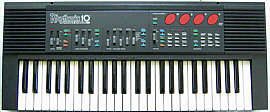 |
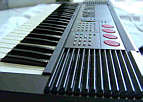 |
(Note: This keyboard sounds nice, but don't buy one of these so far your only intention is to get a keyboard with faithfully imitated natural instrument sounds. Remember, this is a squarewave instrument and though many of its sounds sound not even remotely like what is written on its buttons, though bought with wrong expectation it may disappoint you.)
| base | = dull, short knock |
| conga | = dull drum |
| hihat | = short and quiet transistor noise hiss |
| snare | = popping noise + "hihat" sound |
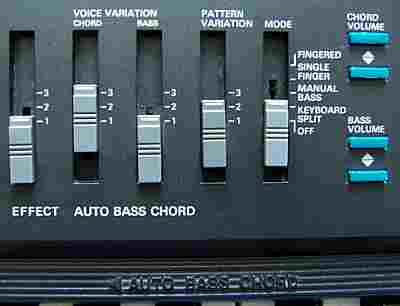 |
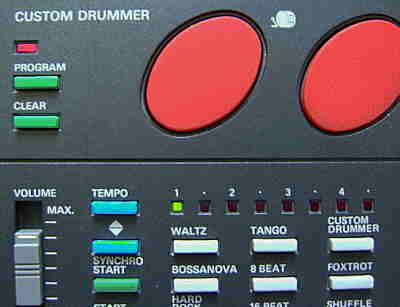 |
 |
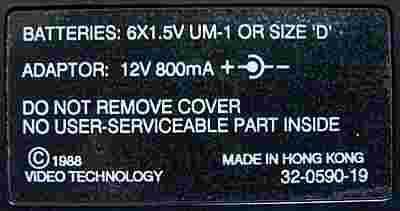 |
 |
 |
 |
The preset sounds seem to be made from multipulse squarewave muffled through different capacitors. They employ simple digital volume envelopes with a dose of zipper noise. As usual with squarewave based instrument, they have a characteristic buzzy bass range, however I am not entirely sure, if here already digital waveforms are used, because some sounds resemble the Antonelli 2495, which employs filtered natural waveform samples. The "saxophone" timbre plays way too dull to sound realistic, and also too quiet unless you manually increase the volume. "organ" is a simple squarewave organ tone with percussive attack phase. "flute" is another dull timbre with soft attack phase, that reminds to a wooden pipe organ rank or muffled reed organ. "chimes" is a semi- metallic multipulse "pipe organ" timbre with percussive envelope. "guitar" employs the harsh "oboe" timbre and reminds to a banjo. "violin" is another typical squarewave timbre, which resembles a saxophone in the bass range. The "clarinet" reminds a bit to a metal pipe organ rank and turns hollow in the bass range; this is not the typical plain squarewave "clarinet" found on other squarewave keyboards. The "music box" is a brighter (unfiltered?) version of "chime" and rather reminds a harpsichord (plain squarewave would sound more realistic here). The "oboe" has a harsh timbre (like intended). The "pipe organ" is the famous multipulse squarewave timbre, but here sounds a bit unpleasantly harsh in the treble (likely by poorly made filters). The "vibraphone" is another semi- muffled timbre that is a bit hollow in the bass and rather resembles a xylophone, but it decays too slow with held keys, and too fast without. The "piano" is otherwise quite ok for a squarewave instrument (filters approximate the timbre well here) and even the attack comes nicely with high notes. When sustain is switched off, all sounds decay fast after releasing the key, and the sound presets itself also contain neither vibrato nor tremolo. The sustain button otherwise adds a 3 seconds sustain, which is already too long in most situations. An unusual behaviour is that the sustain of monophonic played notes stays monophonic and thus is truncated by the next played monophonic note, but the sustain of chords (or other polyphonic note combinations) stays audible when new notes are played. I am not sure if this is a bug or feature - at least it permits interesting play tricks. The vibrato button adds a medium strong 4Hz square vibrato.
Interesting for play tricks is that the OBS preset sound buttons, "vibrato" and "sustain" can also be pressed while keys are held down without stopping their notes. By rhythmically pressing these buttons, this way many arpeggiator- like timbre changes can be created, thus this button field can be regarded as a realtime sound control, and unlike with many other digital instruments, the button field even responds almost immediately without delay. Pressing sound buttons always re-triggers the envelopes of held notes. By the lack of matrix diodes this often causes additional wrong notes when more than one key is held during this, but this can be also regarded as a sound effect.
Beside the OBS preset sounds there is the "voice synthesizer" section, which is simply a 5 step "wave" and a 4 step "envelope" switch those combine 5 preset timbres with 4 preset envelopes. The settings have only numbers instead of names, but the timbres correspond to {"saxophone", "organ", "clarinet", "oboe", "violin"} and the envelopes to {"vibraphone", "violin", "saxophone", "violin" with short sustain}. With pressed sustain button the 4th envelope even produces a 4s long sustain. I really don't understand why not also the "flute", "chimes" and "pipe organ" timbres can be selected here, which unnecessarily limits the capabilities of this wannabe- synth. Instead there is a separate set of "sustain", "vibrato" and "volume" buttons for the synth, which is totally useless since the synth timbre is basically only yet another "preset" sound and thus could easily use the given buttons of the "orchestra" section. Perhaps they were originally designed for a layer mode (that exists in the smaller Rhythmic 8) to mix synth and preset main voice, that was not implemented by unknown reasons. (I haven't searched for such a matrix easteregg yet.) The only benefit from separate buttons is that you can switch back and forward between synth and preset sound with a single OBS switch. As a realtime sound effect you can also here rhythmically play with the "wave" and "envelope" switch with held notes; this makes great gritty timbre changes and the digital switches even respond fairly fast. Only with the bass and chord volume switches this trick doesn't work, since these only affect new notes.
The sound is generated mono, but all sounds beside percussion are routed through an analogue stereo auto- panning effect (primitive rotary speaker simulator), which normally can not be disabled, but only set to 3 different speeds (2Hz, 4Hz, 6Hz). Fortunately you can despite switch it off by moving the "effect" switch into an intermediate position.
The analogue percussion sounds unusually dull and always a little broken. The base is a popping noise, and the hihat is made from white noise and so quiet that with accompaniment it is often barely audible. The snare is just a popping variation of it. Only the conga is a (fairly dull) melodic drum. The rhythm tempo can be adjusted between ridiculously slow and quite fast. The rhythms have a fill-in, which mutes the automatic accompaniment during the fill-in pattern. Like with Letron MC-3, the accompaniment responds a little slow, but fortunately it also accepts wild disharmonic note combinations and not only what establishment considers chords, and you can select between 3 different accompaniment variations and select between 3 bass and 3 chord preset sounds, which makes it nicely versatile. You can even play to the rhythm a monophonic manual bass or 4 note polyphonic manual accompaniment (without bass, using the chord sound) by selecting "manual bass" or "keyboard split". Although in manual bass mode 3 polyphony channels stay unused and thus only 4 instead of 7 notes can be played in the right keyboard half (like with full accompaniment), it sounds still nice.
The drum pattern programming works here more like with Elta KE-6 than the "custom drummer" of the MC-3 While with the latter a user pattern of fixed length is entered step by step with drumpads and a pause button, with the Rhythmic 10 you instead have to select one of the preset rhythms as a template and press the "program" button, which starts the LED chain walking light in the tempo of the rhythm. Then (similar like a Yamaha PortaSound's "custom drummer") you can now add percussion in realtime with the drumpads (starting with an empty pattern). But you can not delete individual percussion sounds or tracks, but only clear the entire user pattern by pressing "clear". You can finish the pattern by pressing "stop" or "start"; the latter seamlessly continues the new rhythm in normal play mode. (Automatic accompaniment works only in play mode; in programming mode the chord section of the keyboard behaves like without rhythm.) If you want to exchange the accompaniment later with the one from a different preset rhythm, simply press "program" again and then the OBS preset rhythm button with the intended accompaniment (this does not delete the user pattern). The programming mode can be also abused as a realtime tekkno drum computer, and you can even play keyboard it in this mode. Although this works nicely intuitive, unfortunately the user pattern of this instrument can be only 8 steps long (only 6 with "waltz"), despite the preset rhythms are made with 16 step resolution. With the MC-3 and all my other similar instruments the user pattern is always 16 steps long.
The demo is the same melody like "Variazione su brani di Mozart" on Amstrad Fidelity CKX100, but shorter and differently arranged. The first bar of the demo even sounds like the first bar of the theme from the Atari 800XL computer game "Darts" by Thorn Emi.
An 61 keys version of the Rhythmic 10 was released as Rhythmic
12 (seen on eBay). A rare predecessor with nicely warm squarewave
timbres was the great Rhythmic 8
(49 midsize keys, pitchbend wheel, strange drum machine with slide switches,
synth voice can be layered with main voice). An older midsize keyboard
by Video Technology was the Rhythmic
2. A keyboard with a quite similar concept like the Rhythmic
10 was the MC-9000 with its midsize variant Thompsonic
TS-33.
| removal of these screws voids warranty... | ||
 |
||
|
|